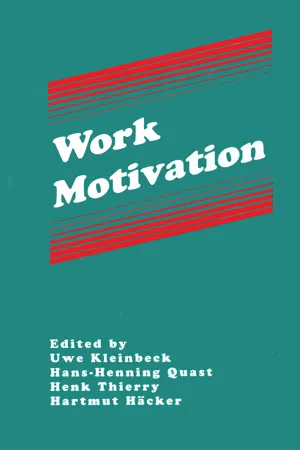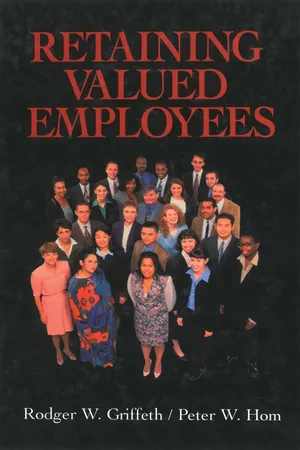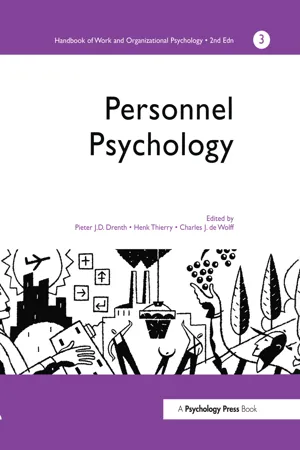Business
Job Characteristics Model
The Job Characteristics Model is a framework that identifies five core job dimensions – skill variety, task identity, task significance, autonomy, and feedback – which can lead to improved job satisfaction and motivation. By designing jobs that incorporate these characteristics, organizations can enhance employee engagement and performance. This model provides a structured approach for creating meaningful and fulfilling work experiences.
Written by Perlego with AI-assistance
Related key terms
1 of 5
10 Key excerpts on "Job Characteristics Model"
- eBook - ePub
- Maria C.W. Peeters, Jan de Jonge, Toon Taris, Maria C.W. Peeters, Jan de Jonge, Toon W. Taris, Toon Taris, Maria C.W. Peeters, Jan de Jonge, Toon W. Taris(Authors)
- 2013(Publication Date)
- Wiley-Blackwell(Publisher)
In general, research on the JCM has been supportive of the core principles, that is, research has shown that the five core job characteristics in the JCM are related to factors such as job satisfaction and intrinsic motivation, although the research is less clear on whether the critical psychological states actually translate the key job characteristics into the outcomes (Parker & Ohly, 2008). Indeed, as other models of job design and chapters in this book indicate, it is not just the motivating potential of job characteristics that can lead to motivation, job satisfaction and performance. For example, it might be that some job characteristics allow workers to solve problems, be more creative, implement minor innovations in how work is performed and develop their own skills through self-directed learning so that they are better able to perform work. The JCM also has some other problems. Some of these are generic to the classic job design models covered in this chapter and will be covered later. More specific to the JCM, the model only examines a narrow range of job characteristics, ignores the social elements of work and concentrates on the positive features of work (see e.g. Morgeson & Humphrey, 2008).Work Psychology in Action: The Job Characteristics ModelOne of the key practical benefits of the JCM is that practitioners are able to compute a motivating potential score(MPS) for jobs and then discern ways in which to improve the MPS for any given job. To do this practitioners need to make accurate assessments of skill variety, task identity, task significance, autonomy and feedback. In 1975, Hackman and Oldham presented an instrument to help practitioners do this. This instrument is known as the job diagnostic survey (JDS). The JDS allows practitioners to assess the five job characteristics and a few ancillary dimensions (e.g. feedback from others), the three critical psychological states, satisfaction with work and motivation. The survey requires workers to answer a series of questions about their jobs by rating the extent to which each job characteristic is present in their job on a seven-point scale. An example question is ‘Does the job require a number of complex or high-level skills?’. Several questions tap into different facets of each of the job characteristics. A score for each job characteristic is created by summing the answers provided. When practitioners have an assessment of each job, they can then proceed to redesign the job to increase those job characteristics that are deficient. - eBook - ePub
- Uwe Kleinbeck, Hans-Henning Quast, Henk Thierry, Hartmut Häcker, Hans Henning Quast, Hartmut H"cker(Authors)
- 2013(Publication Date)
- Psychology Press(Publisher)
This study focused on characteristics of the job content as the determinant of behavior and attitudes of the work performer. Although the researchers were aware of the many possible intervening variables between task attributes and worker responses, they tried to make the “risky leap” between these two classes of variables. The definitions of the variables in this study, in particular regarding the task attributes, can be considered as the origins of the variables in the Job Characteristics Model (JCM). This model proposed by Hackman and Oldham (1975, 1976, 1980) has led to much empirical research. A set of measuring instruments, the Job Diagnostic Survey (JDS), is available to measure the variables in the model. The model states that motivation, satisfaction, and work performance are achieved when three “critical psychological states” (i.e., experienced mean-ingfulness of the work, experienced responsibility for outcomes of the work, and knowledge of the results) are present in the individual. Five “core job dimensions” (skill variety, task identity, task significance, autonomy, and job feedback) are supposed to influence these critical psychological states. Various individual-difference variables (e.g., growth need strength) are conceived as moderator variables of the relationships between job dimensions—critical psychological states and critical psychological states—personal and work outcomes. In addition, the five core job dimensions can also be combined by means of a multiplicative formula to a single score, called motivating potential score (MPS), which is an indication of job complexity. The JDS and the model are for the explicit purpose of task redesign. The Job Characteristics Model can be viewed as belonging to the “task characteristics approach” (see Fleishman & Quaintance, 1984). In this approach tasks are considered as a set of conditions that are imposed on the task performer - eBook - PDF
- Rodger W. Griffeth, Peter W. Hom(Authors)
- 2001(Publication Date)
- SAGE Publications, Inc(Publisher)
Titled the task characteristics model, its creators (Hackman & Old-ham, 1976, 1980) based it on sound principles of internal motivation. They went to considerable lengths to describe a very rich model with conditions or psychological states needed for creating internal motivation. They proposed job or task characteristics that influence or foster these states; created a sum-mary index for determining the overall potential of job norms for a large number of occupations; and described useful principles that managers can use for enriching work. Since then, a great deal of empirical research has been de-voted to testing most of the basic tenets of the model. The result is a reason-ably robust model of the JE process. In this chapter, we describe each com-ponent of the model and show how you can use it to increase a job's intrinsic motivation and retain valued employees. Overview of the Task Characteristics Model The basic model is relatively simple. By increasing a job's scope or com-plexity, viewed subsequently as the task characteristics, employees will find work more motivating and attractive (work outcomes) because the critical psychological states are enhanced. It proposes the following basic relations: Core Job Characteristics -» Critical Psychological States —> Work Outcomes Thus, work outcomes are enhanced to the extent that the job has critical psy-chological states. Hackman and Oldham (1980) proposed three states that are an essential component of each job. Employees need to learn from the job by knowing the results that they themselves were personally responsible for creating and on a job they felt was meaningful. These states are derived from basic task characteristics of a job: skill variety, or using various skills and talents to perform the work; task identity, or doing a whole and identifi-able piece of work; and task significance, or doing work that substantially affects the work or lives of others. - Steven G. Rogelberg(Author)
- 2006(Publication Date)
- SAGE Publications, Inc(Publisher)
motivators ) caused satisfaction, whereas extrinsic “hygiene” factors external to the job (e.g., pay) caused dissatisfaction. Although appealing, this theory has not stood the test of time. In fact, both types of factors contribute to both job satisfaction and job dissatisfaction.A more enduring theory that focuses on situational causes of job satisfaction is the Job Characteristics Model (JCM). This model proposes that there are certain intrinsically motivating features of a job that lead to job satisfaction as well as other positive work outcomes. The theory focuses on five work characteristics:- Task identity: degree to which one can see one’s work from beginning to end
- Task significance: degree to which one’s work is seen as important and significant
- Skill variety: extent to which job allows employees to do different tasks
- Autonomy: degree to which employees have control and discretion for how to conduct their job
- Feedback: degree to which the work itself provides feedback for how the employee is performing the job
According to the theory, and as subsequently demonstrated in both meta-analyses and rigorous longitudinal field studies, jobs that are enriched to provide these core characteristics are more satisfying and motivating than jobs that do not provide these characteristics.A theory that has parallels with the JCM is the demand-control model of strain, which proposes that job demands and job control work together to affect job strains, including dissatisfaction. There is good evidence that people are more satisfied if they have jobs with high control and with moderate levels of demands. However, there is mixed support for the more specific “buffering” hypothesis that has often been articulated in accounts of this model, which holds that job control reduces the dissatisfying effects of high demands. This is a compelling proposition, because it implies one can increase job demands without detriment to employee well-being so long as employees also have high control.Practically, the implication of both the JCM and the demand-control models is that one can improve job satisfaction by changing job characteristics, or job redesign. For example, job enlargement involves expanding the variety of tasks associated with a particular job; job enrichment involves increasing the level of autonomy in a job, such as by allowing individuals to make decisions previously made by supervisors; and introducing self-managing teams involves increasing autonomy for a team of individuals, such as by allowing the group to allocate tasks among themselves.- eBook - ePub
A Handbook of Work and Organizational Psychology
Volume 3: Personnel Psychology
- De Charles, P J D Drenth, THIERRY HENK, Charles, De, Wolff(Authors)
- 2013(Publication Date)
- Psychology Press(Publisher)
An important shortcoming of the JCM of a more general nature is that the model is static. The model does indicate which relations exist between task characteristics and dependent variables, but says nothing about the role of the factor time. Indeed, there are very few research results regarding the effect of the factor time. One exception is the research of Katz (1978a, 1978b), where it is suggested that the factor time operates as a moderator of the relation between task characteristics and satisfaction. He investigated the effect of the time of experience with a job on the relation between task characteristics and satisfaction. It turned out that the correlation between the task characteristic autonomy and satisfaction was negative for new task performers (0-3 months on the job). For task performers who had been working on the job for longer periods the correlation was positive. The highest correlation was found where people had been working on their job for about a year, after which there was a slow decrease that tailed off to nearly zero for people who had been working for over 15 years in the same job. Kozlowski and Hults (1986) made an analysis of the time one had been working in the same job and its effect on the relation between task complexity and work performance in a sample of engineers. They found an extremely strong moderating effect for the time one had spent working in the same job for engineers working in research and development departments. The relation between task complexity and work performance is low in the period 0-1.5 years in the job. It rises during the period 1.5-4.5 years in the job and then decreases considerably if one works in the same job for over 4.5 years. For engineers working in staff departments a very gradual decreasing correlation was found between task complexity and work performance the longer people are working in the same job. Griffin (1991) presents a longitudinal study that shows an improvement of the quality of work performance, but only a year after the job redesign intervention. This also illustrates that job redesign takes time to have its effects on work performance.Summarizing, we may conclude that the JCM as an integral model finds no overall support in the results from empirical research. This particularly holds for the precise causal relations postulated in the model and for the mediating role of the critical psychological states. On the other hand, there is much empirical support for the effect of task characteristics on dependent variables, although these effects are stronger for the way people experience work (e.g. satisfaction) than for work performance. Vogelaar and van der Vlist (1995) conclude that job redesign on the basis of JCM has an immediate effect on attitudinal variables and a delayed effect on behavioural variables. That is why it can be expected that modifications of the JCM will be developed in future research into the effects of task characteristics.The JCM as an Intervention Strategy for Job (Re)design
As mentioned earlier, the JCM and the corresponding instrument (the JDS) were introduced to help in job (re)design (Hackman et al., 1975). From an overview of the empirical research regarding this model it turns out that the major part of the research is focused on testing (parts of) the model. Few studies are aimed at the JCM as a guideline for interventions in actual practice. Loher et al. (1985) express their concern about the small number of studies in professional literature that report on actual interventions. Basically, the emphasis is placed on the JCM as a model that diagnoses a situation rather than the JCM as a vehicle to implement actual changes in tasks. - eBook - PDF
- Josiane Fahed-Sreih(Author)
- 2020(Publication Date)
- IntechOpen(Publisher)
The needs of employees toward the work itself can be further realized through job characteristic theory. In other words, this theory helps to answer the question of how to design a task to make employees feel satisfied. Job characteristic theory suggested that job dimensions such as task identify, task significance, skill variety, autonomy, and feedback impact employees’ satisfaction with the work itself [3, 74]. Among these dimensions, skill variety, task identities, and task significance together produce a sense of meaningfulness of work, which reflects the extent the work tasks fit in the employees’ value and beliefs. The dimension of autonomy allows employees to experience the responsibility for outcomes of the work. 35 Job Training Satisfaction, Job Satisfaction, and Job Performance DOI: http://dx.doi.org/10.5772/intechopen.89117 Responsibility for outcomes refers to the extent the employees feel that they are responsible for the quality of the work. Providing either positive or negative feed-back to employees make them have the opportunities to know the actual results of the work activities. Knowledge of results means that employees know how well or poorly they are doing. Thus, research suggests that the higher the three psychologi-cal states, the higher the working motivation, which leads to higher job satisfaction. An employee who has a high level of job satisfaction holds positive feelings toward his or her job, while he/she may hold negative feelings if he/she has a low level of job satisfaction [3]. 3.3 How important is job satisfaction? The next question to be answered is “does job satisfaction really matter?” This question can be answered through elaborating the relationship between job satisfac-tion and job performance, job commitment, organizational citizenship behavior (OCB), absenteeism, and turnover. First, a number of researchers have been curious about the relationships between job satisfaction and job performance. - eBook - PDF
- Jeffrey H. Greenhaus, Gerard A. Callanan, Jeffrey H. Greenhaus, Gerard A. Callanan(Authors)
- 2006(Publication Date)
- SAGE Publications, Inc(Publisher)
During the late 1960s, Herzberg’s notion of separate determinants of job satisfaction and dissatisfaction generated more empirical research than any other job-design strategy and was embraced by many practition-ers. Over the years, however, many critics have questioned Herzberg’s theory and methodology because other research studies failed to replicate his findings. Not surprisingly, Herzberg’s two-factory theory lost credibility and has not proved to be a useful guide for practicing managers. Nonetheless, the notion of job enrichment—designing jobs that satisfy higher-order needs for responsibility, recognition, achievement, and growth—continues to influence job-design efforts and stimulate interest in motivation and job satisfaction. Another major development in the field of job design that is one of the best-known approaches to job enrichment is the Job Characteristics Model. In 1975 and 1976, J. Richard Hackman and Greg Oldham identified five core job dimensions: skill variety, task identity, task significance, autonomy, and feedback. These five core job characteristics influence the extent to which workers experience three critical psy-chological states. The first of these is experienced mean-ingfulness: the belief that one’s work is worthwhile or important. Skill variety, task identity, and task signifi-cance combine to influence the experienced meaning-fulness of work. The second psychological state is experienced responsibility: the degree to which work-ers feel personally accountable and responsible for the results of their work. Autonomy contributes to the worker’s experienced responsibility for work out-comes. Employees must have the opportunity to control their work environments in order to feel responsible for their successes and shortcomings. The final psychological state is knowledge of results: the degree to which employees are aware of the effective-ness of their work or understand how they are per-forming. - eBook - PDF
- George B. Graen, Joan A. Graen(Authors)
- 2013(Publication Date)
- Information Age Publishing(Publisher)
However, the current evidence suggests that the contribution of autonomy on employee reactions is contingent on the level of other job characteristics in the model. This further suggests that in the process of 184 Y. FRIED, A. S. LEVI, and G. LAURENCE facilitating job design or job crafting, the leader should be aware of the importance of the fit between job complexity/simplicity and autonomy. Addressing job design from the standpoint of only one or a few job char-acteristics, rather than all five characteristics, may not produce the expected results, and in some cases may result in adverse outcomes. Changing the Relational Characteristics of the Job When leaders find it difficult to facilitate changes in job characteristics that would satisfy employees’ desire for growth (because of the reasons described above), they may focus instead on changing the relational archi-tecture of the jobs to shape employee motivation (e.g., Grant, 2007). More specifically, the literature supports the notion that people care about positively affecting other people’s lives, and that a major purpose of employees at work is to make a positive difference in others’ lives (Colby, Sippola, & Phelps, 2001; Ruiz-Quintanilla & England, 1996). The JCM has recognized this important need by including task significance as one of the five core job characteristics (Hackman & Oldham, 1980). How-ever, the theory focuses on how the structure of task significance (and the structure of all other task characteristics) affects employees’ experience of meaningfulness and motivation at work, and neglects to recognize the importance of the relational part of task significance on meaningfulness and work motivation (Grant, 2007). - eBook - PDF
- Alan M. Saks, Jamie A. Gruman(Authors)
- 2021(Publication Date)
- Edward Elgar Publishing(Publisher)
ADVANCED INTRODUCTION TO EMPLOYEE ENGAGEMENT 30 3.1.1 Job characteristics theory Job characteristics theory is a theory of job design that explains how to design jobs so that they will promote high levels of intrinsic motivation. The theory is based on the idea that there are five core job characteristics (skill variety, task identity, task significance, autonomy, and feedback from the job) that will have a psychological effect on workers and lead to positive work outcomes. The basic idea is that when you design a job that is high on these five core job characteristics it will lead to three critical psychological states (experienced meaningfulness of the work, experi- enced responsibility for outcomes of the work, and knowledge of the results of work activities), and the three psychological states will then lead to higher intrinsic work motivation and other positive work outcomes (Hackman & Oldham, 1980). Research on job characteristics theory has found that the five core job characteristics are positively related to a variety of work outcomes such as intrinsic motivation, job satisfaction, and organizational commitment. In addition, some of the core job characteristics are also positively related to behaviors such as absenteeism and performance. Among the critical psychological states, experienced meaningfulness has been found to be the most important in terms of its relationship with work outcomes (Humphrey et al., 2007). Job design and the job characteristics have often been used in research on employee engagement. In fact, Kahn (1990) based his theory in part on job characteristics theory in that his theory of personal engagement also includes three psychological conditions that are influenced by various antecedents and lead to engagement. Kahn (1990) noted that the extent to which people are engaged is based on their psychological experiences of self-in-role similar to the way critical psychological states influence intrinsic motivation. - eBook - PDF
Organizational Psychology and Organizational Behavior
Evidence-based Lessons for Creating Sustainable Organizations
- Steve M. Jex, Thomas W. Britt, Cynthia A. Thompson, Cynthia A Thompson(Authors)
- 2024(Publication Date)
- Wiley(Publisher)
That is, organizations with higher POS tended to have better- performing employees and employees that stayed with the organization, resulting in higher profitability. Job (Employee) Engagement Another important job belief that has received a great deal of attention by organi- zational scientists is job engagement. The most popular conceptualization of job engagement includes three components: vigor, absorption, and dedication (Bakker & Demerouti, 2017). Vigor represents a heightened sense of feeling energized by one’s work, while absorption is characterized by being so involved in one’s work that one loses one’s sense of time. Finally, dedication represents a heightened sense of commit- ment toward one’s work and the feeling that what one is doing is significant. Given the nature of engagement, it is quite possible that the core job dimensions of the JCM dis- cussed earlier tend to increase it, which in turn leads to positive outcomes; for exam- ple, it has been shown that both autonomy and feedback are related to the vigor com- ponent of engagement (Van Den Broeck et al., 2008). Christian et al. (2011) conducted a meta- analysis of 91 studies and found that job engagement was positively related to all five of the core job dimensions from the Job Characteristics Model (see Chapter 9). Moreover, these authors also found that job engagement partially mediated the relationship between three of the core job dimensions (task variety, task significance, and task identity) and job performance. These findings, combined with other evidence suggesting that job engagement may buffer the effects of work stressors (e.g., Britt et al., 2005), suggest that job engagement is clearly an important moti- vational construct that warrants further attention. Macey and Schneider (2008) point out, however, that there is considerable debate and disagreement sur- rounding both the definition of job engage- ment and its measurement.
Index pages curate the most relevant extracts from our library of academic textbooks. They’ve been created using an in-house natural language model (NLM), each adding context and meaning to key research topics.









